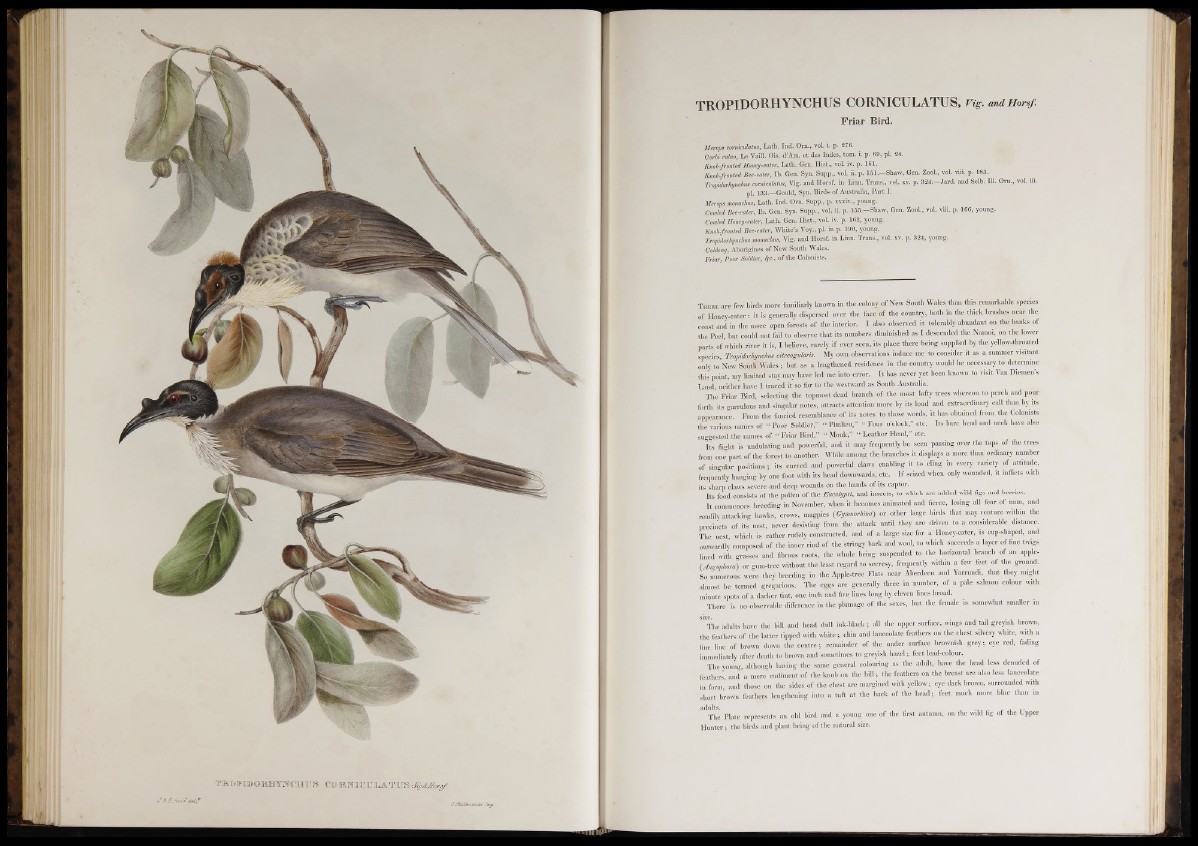
TROPIDORHYNCHUS CORNICULATUS, Vig. and Horsf.
Friar Bird.
Merops corniculatus, Lath. Ind. Om., vol. i. p. 276.
CorU calm, Le Yaill. Ois. d’Am. et dea Indes, tom. i. p. 69, pi. 24.
Knol-frontei Honey-eater, Lath. Gen, Hist., vohiv, p. 161.
K n o b - fr o n t e d B e e - e a te r , lb. Gen. Syn, Supp.vol. ii. p. l .i l.—Shaw, Gen. Zool., vol. vim p. 183.
Tropidorhymhm corniculatus, Vig. and Horafj in Linn. Trans,, vol. x f. p. 324—Jard. and Selb. 111. Om, Yol. m.
pl. 133.—Gould, Syn. Birds of Australia, Part I.
Merops monachus, Lath. Ind. Om. Supp., p. xxxiv., young.
Cowled Bee-eater, lb. Gen. Syn. Supp., v o l. ii. p. 155.-Shaw, Gen, Zool., yoI. viii. p. 166, young.
Cowled Honey-eater, Lath. Gen. Hist., vol. iv. p. 162, young.
Knob-fronted Bee-eater, White’s Voy., pl. in p. 190, young.
Tropidorhynchus monachus, Vig. and Horsf. in Linn. Trans., vol. xv. p. 324, young.
Coldong, Aborigines of New South Wales.
Friar, Poor Soldier, fyc., of the Colonists.
Thebe are few birds more familiarly known in the colony of New South Wales than this remarkable species
of Honey-eater : it is generally dispersed over the face of the country, both in the thick brushes near the
coast and in the more open forests of the interior. I also observed it tolerably abundant on the banks of
the Peel, but could not foil to observe that its numbers diminished as I descended the Namoi, on the lower
parts of which river it is, I believe, rarely if ever seen, its place there being supplied by the yellow-throated
species, Tropidorhynchus citreogulans. My own observations induce me to consider it as a summer visitant
only to New South Wales ; but as a lengthened residence in the country would be necessary to determine
this point, my limited stay may have led me into error. It has never yet been known to visit Van Diemen’s
Land, neither have I traced it so far to the westward as South Australia.
The Friar Bird, selecting the topmost dead branch of the most lofty trees whereon to perch and pour
forth its garrulous and singular notes, attracts attention more by its loud and extraordinary call than by its
appearance. From the fancied resemblance of its notes to those words, it has obtained from the Colonists
the various names of •• Poor Soldier,” “ Pimlico,” “ Four o’clock,” etc. Its bare head and neck have also
suggested the names of “ Friar Bird,” “ Monk,” “ Leather Head, etc.
Its flight is undulating and powerful, and it may frequently be seen passing over the tops of the. trees
from one part of the forest to another. While among the branches it displays a more than ordinary number
o f singular positions; its curved and powerful claws enabling it to ding m every variety of attitude,
frequently hanging by one foot with its head downwards, etc. If seized when only wounded, it inflicts with
its sharp daws severe and deep wounds on the hands of its captor.
Its food consists of the pollen of the Eucalypti, and insects, to which are added wild figs and berries.
It commences breeding in November, when it becomes animated and fierce, losing all fear of man, and
readily attacking hawks, crows, magpies QGymnorhind) or other large birds that may venture within the
precincts o f its nest, never desisting from the attack until they are driven to a considerable distance.
The nest which is rather rudely constructed, and of a large size for a Honey-eater, is cup-shaped, and
outwardly composed o f the inner rind of the stringy hark and wool, to which succeeds a layer of fine twigs
lined with grasses and fibrous roots, the whole being suspended to the horizontal branch of an apple-
(Angophora) or gum-tree without the least regard to secresy, frequently withm a few feet o f the ground.
So numerous were they breeding in the Apple-tree Flats near Aberdeen and Yarrundi, that they might
almost be termed gregarious. The eggs are generally three in number, of a pile salmon colour with
minute spots of a darker tint, one inch and five lines long by eleven lines broad.
There is no observable difference in the plumage of the sexes, but the female is somewhat smaller in
size. . - i i
The adults liave the bill and head dull ink-black; all the upper surface, wings and tail greyish brown,
the feathers of the latter tipped with white; chin and lanceolate feathers on the chest silvery white, with a
fine line of brown down the centre; remainder of the under surface brownish grey; eye red, fading
immediately after death to brown and sometimes to greyish hazel; feet lead-colour.
The young, although having the same general colouring as the adult, have the head less denuded of
feathers, and a mere rudiment of the knob on the biU; the feathers on the breast are also less lanceolate
in form,’ and those on the sides of the chest are margined with yellow; eye dark brown, surrounded with
short brown feathers lengthening into a tuft at the back of the head; feet much more blue than in
^ T h e Plate represents an old bird and a young one of the first autumn, on the wild fig of the Upper
Hunter ; the birds and plant being of the natural size.